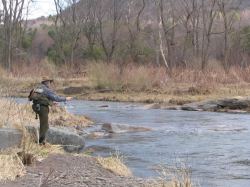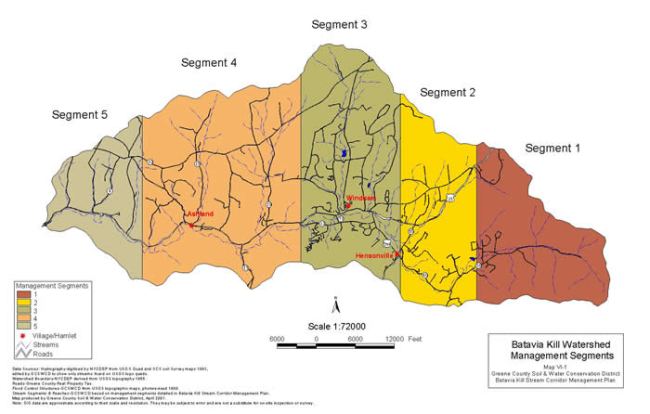A component of the Batavia Kill Stream Management Pilot
Project the Batavia Kill Stream Management Plan (SMP) was developed after 4 years of watershed and stream corridor assessment in the Batavia Kill watershed. Since 1997, the GCSWCD and NYCDEP have been assessing watershed conditions, monitoring stream stability and undertaking demonstration restoration projects. Based on the data collected and input from various watershed stakeholders, the GCSWCD and NYCDEP completed the Batavia Kill SMP in 2003.
Cover and Table of Contents
Executive Summary
Introduction
Introduction to Stream Management (3.5 MBs)
Watershed Description
 This section provides watershed background information and characteristics which influence the Batavia Kill. A chapter on living streamside and stream related activities may be of particular interest to landowners, answering commonly asked questions, including necessary permits and agency contacts, relating to activities which may impact stream health or stability.
This section provides watershed background information and characteristics which influence the Batavia Kill. A chapter on living streamside and stream related activities may be of particular interest to landowners, answering commonly asked questions, including necessary permits and agency contacts, relating to activities which may impact stream health or stability.
Regional Setting
Watershed History
Physiography
Geology & Topography
Water Resources
Wetlands & Floodplains
Aquatic & Terrestrial Wildlife
Riparian Vegetation
Land Use & Land Cover
Population and Demographics
Infrastructure
Flood Control District
Institutional Resources
Watershed Programs
Assessment of the Batavia Kill
This section includes a summary of water quality assessments that have been undertaken over the years in the Batavia Kill, an introduction to the science of stream processes, and a description of the watershed assessment protocol used to develop this stream management plan.
Assessment Introduction
Water Quality Assessment
Watershed Inventory and Assessment
Stream Corridor Level Assessment
Stream Reach Description & Recommendations
This section contains very detailed descriptions and specific recommendations for the Batavia Kill, from the headwaters at the top of the watershed, downstream to its confluence with the Schoharie Creek, located in the Town of Prattsville. The Batavia Kill mainstem has been organized into 5 Management Units (MUs), defined using physical stream characteristics, historical channel alignments, location of bridges and road infrastructure, and valley characteristics. These MU descriptions outline stream conditions (its bed and banks), general streamside (riparian) vegetation condition, and proximity and arrangement of roads, bridges and culverts.
Reach Summary Introduction
Management Segment Map
Management Segment 1 Intro
Management Unit 1a
Management Unit 1b
Management Unit 1c
Management Unit 1d
Management Segment 2 Intro
Management Unit 2a
Management Unit 2b
Management Unit 2c
Management Segment 3 Intro
Management Unit 3a
Management Unit 3b
Management Unit 3c
Management Segment 4 Intro
Management Unit 4a
Management Unit 4b
Management Unit 4c
Management Unit 4d
Management Unit 4e
Management Unit 4f
Management Unit 4g
Management Segment 5 Intro
Management Unit 5a
Management Unit 5b
Management Unit 5c
Management Unit 5d
Batavia Kill Demonstration Projects
General Recommendations for Stream Protection/Enhancement
This section sets forth an extensive list of recommendations related to education and outreach, flood protection, water quality, public enjoyment, fisheries, riparian zone management, stream management, and programmatic issues, providing a frame work for watershed stakeholders to develop a long term management strategy to protect and improve the Batavia Kill.
| Greene County Soil & Water Conservation District 907 County Office Building Cairo NY 12514 Phone: 518-622-3620 Fax: 518-622-0344 Abbe Martin, Project Manager abbe@gcswcd.com |
NYCDEP Stream Management Program 71 Smith Ave, Kingston NY 124021 Phone: 845-340-7850 Fax: 845-338-1367 David Burns, Project Manager dburns@dep.nyc.gov |
